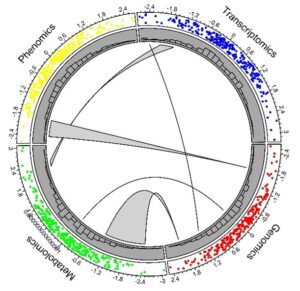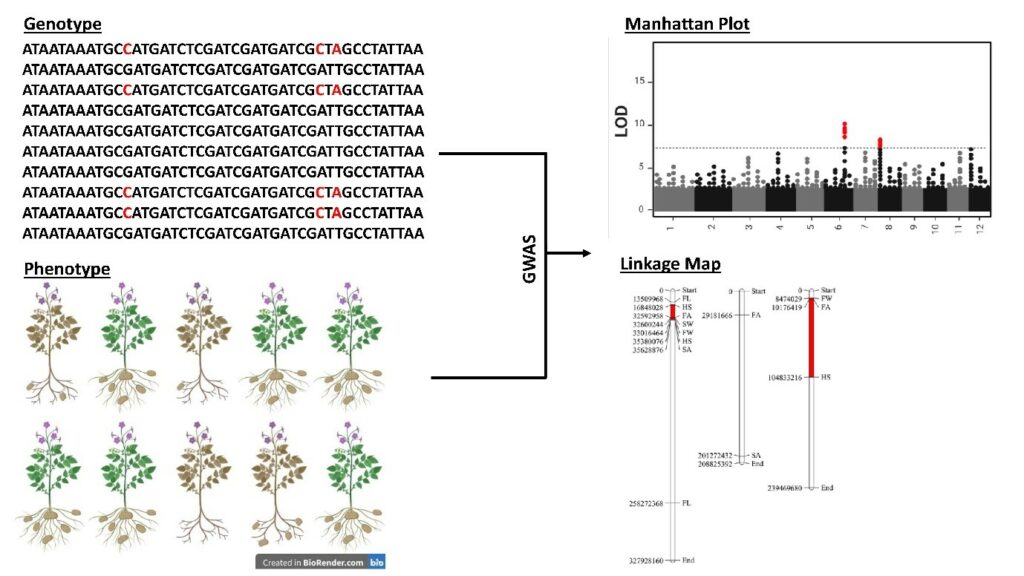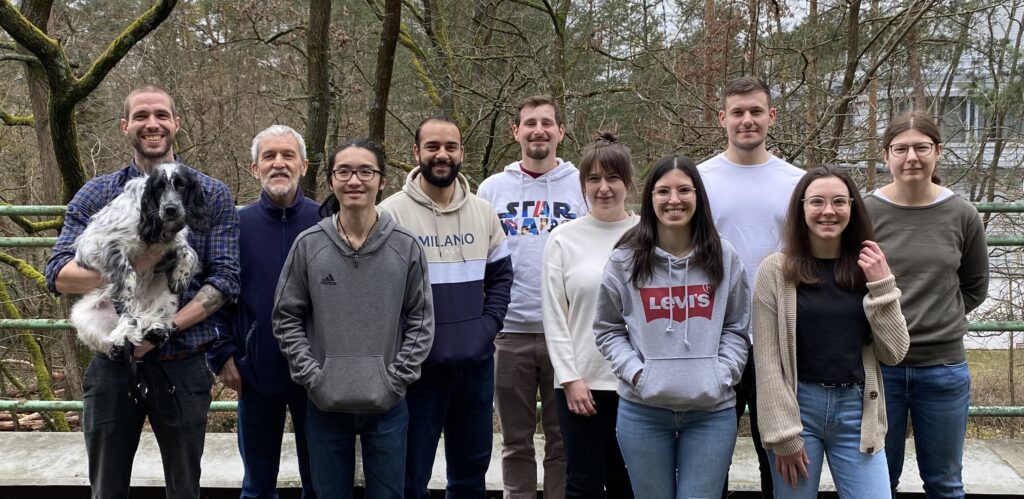Biocomputing – Group Stephan Reinert

Food security, consumer preferences, and the imminent threats of the global climate change represent strong forces for breeders to find fast and efficient ways to develop new crop varieties accordingly. As a result, a precise and deep knowledge of abiotic stress resistance and the underlying genetic factors in plants is of utter most importance to find new targets for crop improvement.
The aim of our research is the analysis of different major and minor crop plants to reveal genomic and transcriptomic variations leading to improved crop performance under various stress conditions. To identify these factors we use state-of-the-art statistical and bioinformatic tools from the field of quantitative and population genetics to analyze and integrate diverse data sets such as genomics, transcriptomics, metabolomics, and phenomics. This helps us to disentangle gene regulatory networks and the genetic basis of complex traits and to find new targets for molecular breeding.
Currently, our research focuses on the multi-omics analysis of two important starchy crop plants, cassava (Manihot esculenta) and potato (Solanum tuberosum).
Cassava is a woody shrub that develops starchy underground storage roots and is one of the most important crops for food security, especially in the tropics and subtropics. Although it is the most important staple food for more than 800 million people in the Americas, Africa, and Asia, it is primarily grown by smallholder farmers. Because smallholders have only limited access to the tools of modern agriculture, like heavy farming machinery, pest control or fertilizer, yield increase must come from plants that are inherently more productive, even under conditions of low-input agriculture. Therefore, our research, as a part of the Cassava Source-Sink (CASS)-project, is dedicated in developing robust and yield-improved cassava varieties that will be provided to African smallholder farmers to improve food security in Sub-Saharan Africa.
Potato is one of the most important food crops globally and ranks third only behind the cereals rice and wheat. Due it’s steady increase in overall production it is considered an important staple food source. The modern cultivars originated from the Andes in South America between Bolivia and Peru. Domestication of wild potato dates back nearly 8,000 years. Cultivated potatoes were introduced into Europe in the 1570s and were distributed globally in the late 17th century. Today, potatoes are grown world-wide from latitudes of 65⁰N to 50⁰S and from altitudes of up to 4,000 m. This demonstrates the immense adaptability of potato to many different environmental conditions. Even though potato is well adapted to a variety of environmental conditions, it shows a high sensitivity to abiotic stress conditions such as heat and drought. Especially high temperature (temperatures above 20⁰C) impacts tuber production of potato negatively.

Due to the vastly changing climate, increasing global population, and the necessity to produce food even under suboptimal conditions, we are working with national and international partners to improve cassava and potato in three main projects. For details on each project please feel free to contact the PhD student working on the project or out group leader (Stephan Reinert).
- Improving the productivity of cassava (Sindy Gutschker)
Unfortunately, conventional cassava breeding is very time-consuming, and it often takes several years before an improved variety can be approved. For this reason, as one of the bioinformatics parts of the CASS project consortium, we are working to complement conventional breeding and use bioinformatics approaches to achieve accelerated research success. For that, we use a wide variety of state-of-the-art methods including RNA (RNAseq) and whole genome sequencing (WGS) data analysis; expression-based genome- and transciptome-wide association studies (GWAS, TWAS, eGWAS); comparative analysis using clustering, association, regression, and dimensionality reduction methods; as well as the integration of phenotypic, metabolomic, and proteomic data. We are especially interested in agronomic, agro-morphological, as well as biotic and abiotic stress traits such as storage root quality, cassava mosaic disease, and cassava green mite severity to name just a few.
- Heat tolerance in potato (Alexander Kaier)
In our potato heat tolerance project we are especially interested in the agronomic traits, tuber starch content and tuber yield under heat stress conditions. By performing GWAS on genotype and the agronomic trait data of all potato varieties we will be able to identify candidate genes which are important for heat tolerance. Using these candidate genes in subsequent transcriptome and gene structure analyses we will get a better understanding of the underlying genetic mechanisms and factors for heat tolerance in potato as well as present new targets for molecular breeding to potato breeders.
- Epigenetics of heat tolerance in potato (Darren Yeo)
During the last decade, it is becoming increasingly clear that agronomic traits of crops such as tuber size and yield are inextricably linked with epigenetic regulation because of environmental stresses. Epigenetic gene regulation refers to the regulation of gene expression by modifying the genome without altering the sequences in the genome. One such epigenetic modification is the methylation and demethylation of cytosines. Methylation patterns may differ among different genotypes, individual plants or even among the tissues and are often associated with environmental stresses including heat stress. This phenomenon could potentially be true for potatoes as well when grown under heat stress. Thus, we aim to profile the methylation patterns among contrasting potato genotypes that are heat-resistant and heat-sensitive grown in order to identify specific methylation regions that potentially regulate gene expression of candidate genes.

